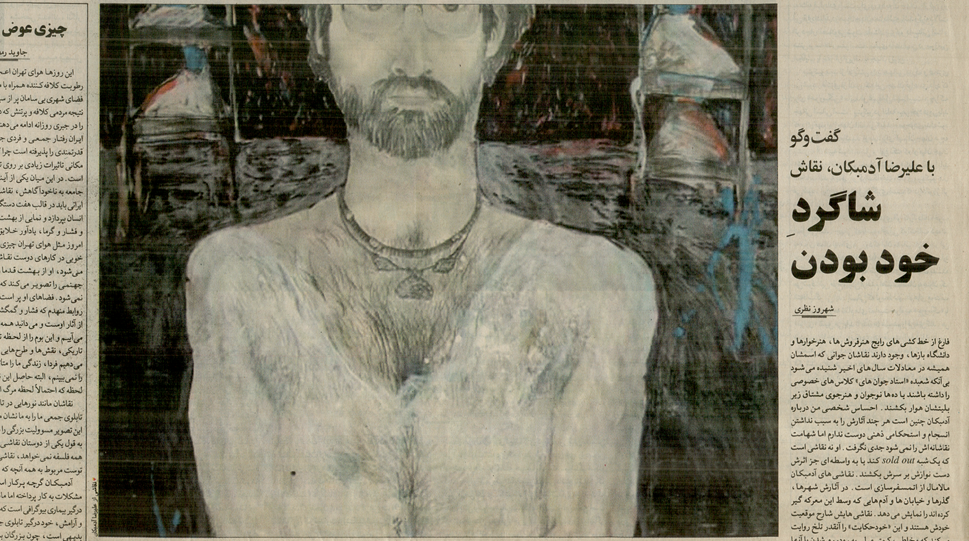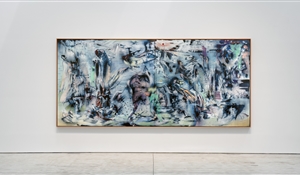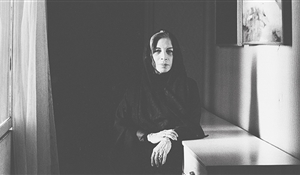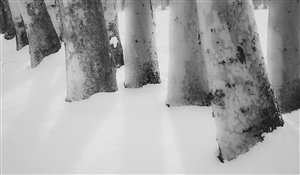Interview with Alireza Adambakan, Painter
01 May 2022Being Your Own Apprentice
Written by Shahrooz Nazari | Shargh Newspaper | Sunday, July 22, 2007
Regardless of common categorizations by art dealers and academics, there are young painters whose names have always been heard in recent years without juggling in private classes as "young masters" and have dozens of students serving them. These were my personal feelings about Adambakan, although I do not like his works for lack of cohesion and strength, his courage in paintings cannot be disregarded. His paintings are not sold out overnight, nor get attention by mercy. The paintings of Adambakan are enriched with creating different atmospheres, displaying cities, passages, streets, and people stuck in the middle. His paintings describe himself, they are some poignant self-narratives that the audience is reluctant to face. The self-narrative spirit of the works may seem expressionist in appearance and form but are realistic in nature. His works have been seen for a decade, yet they have not received much attention from the community of dealers and collectors due to not being decorative. Alternatively, his conceited spirit in choosing his viewpoint has made the paintings unique in his field, and having no continuation may be the main feature of his paintings. We are facing a person who has not exchanged the individual characteristics of his painting with many other things. Here are four reasons to have a friendly chat with him on the lawns around the Iranian Artists Forum: First, his fifth solo show at the Iranian Artists Forum, second, being the artist whom we pursued his artistic background since the early 2000s, third, his detachment from visual arts' propaganda and social media and fourth, avoiding participating in the futile artistic meetings. Javid Ramezani and Amir Farhad were also present, making this interview more interesting and pushing Adambakan to answer the questions. Now that I had my first conversation with him, I know that his shyness might be the reason why his paintings are less noticed. It must be the inevitable spirit of media and business that does not follow the works of people who do not establish a relationship with them! A precondition that can be accepted or not, for this, we have to wait and watch this meticulous painter in the future.

Alireza Adambakan | Untitled | Landscapes | 2005 | oil on cardboard | 30 × 48 cm
- You are one of the few young painters who are not trying to gather groups or train students. Is this true, and if it is, why are you doing this?
To be honest, I only have one class at the university, and of course, if I didn't have to afford my living costs, I wouldn't teach at all. I'm afraid of teaching, I'm afraid of people reproducing students like themselves. If I didn't have to, I would give up this single class too. The issue of "apprentices following the steps of their instructors" always bothers me. Maybe if I wasn't honest, I would have engaged myself in these things, but I don't know why I can't. Maybe I'm incapable of doing so and that is why my relationships never develop.
- Has anyone influenced you the most during your studying years?
Ahmad Vakili says the right thing about me: "You were always present in class, but you weren't there." Without being selfish I have to say that I have been my own apprentice. I have learned a lot from Manouchehr Motabar, Vakili, and others. One sentence from these people was enough for me to learn.
- In these years, have you ever changed your view of painting according to the acceptance of your works?
I can't comment definitively, maybe it wasn't very tangible. For instance, I had a show in Europe Art (in Geneva) in 1999. My thirty paintings were sold, although I didn't get much money and everything was spent on the show itself, it gave me some kind of reassurance, except for that particular case, I've always had a smooth movement.
- One or two of your works reminds me of Philip Guston. Has a painter affected you particularly?
Maybe it is good or maybe it's wrong; I don't know how to work with the Internet, so I am not familiar with a lot of currents and a lot of people. I do not know the painter you just mentioned, but I like to know how he paints, for when I see good works, I can learn from them. I'm still attached to Gauguin and Van Gogh, when I see Schiele's work, I enjoy its visual quality, but I'm not looking to imitate them. I also learn from Michelangelo's incomplete sculptures (not his final works), but my learning is summed up by studying the artist's actions and conversations in his work.
- There were scattered writings of yours on the invitation card and in the hall. What is the perfect relationship between literature and image for you?
I am thinking about what you are saying now, but I don't have plans for them. Sometimes after painting three to four works, if they do not respond to my emotional incitement, I go for the literature and write something. I do not deny the connection between my paintings and literature, but for me, both are themes. Many times, I have avoided the literacy narrative of my works and have not displayed them. In this show, there are two paintings in which I have used literature, but I do not know their boundaries with my painting, of course, I do, but it is so personal and private that my audience may not understand them.
- Creating atmosphere is so dominant in your works, to the extent that you get so involved in expressing them, and it is like you forget or ignore the figures. Doesn't this impair some of your works?
Well, this came from the show's installation, as the transposition in the works has not been considered, so we can see this defect. I don't do the sketching, I draw the figures first, then the rest of the work gets painted. In this period of my work, I deliberately took the figures weaker than the rest of the components, however, this is not the case in all my works. Of course, I had a few months of break that disturbed my mental order.
- Recently, I saw three portraits from you at Aria Gallery, where the figures were much more coherent.
That special work was the first painting of this period.
- With this flow of large-scale painting becoming prevalent these days, aren't you tempted to go for gigantic frames?
Unfortunately, my studio is so small that I cannot test myself on large scales. Whenever I have had a place to do this, I have assessed myself on such dimensions, for example at the International Exhibition of the Muslim World.
- I ask this question because sometimes in smaller works your color excitements look like dripping paint, wouldn't it be different in other dimensions?
The fact is that I'm not involved in paint technology. I have tried all sizes and dimensions. The fate of each work is not in my control. But many of the shortcomings you mentioned are because of financial issues.
- Can you explain more frankly?
I have worked with the press for many years; Payam-e Khordad, Jam-e Jam, Hamshahri, and even Tandis. In those years, I was writing and sometimes getting them published. However, when I saw that I can't speak clearly, my interests were ignored, or when there were modifications in my writings or censorship, then I didn't continue. I couldn't work like this and I gave up. You certainly know what is going on and my conscience won't allow me to do anything at any price. The same story happens in the painters' community.
- Why aren't you well-known in the painters' community?
The potential around me doesn't let me do anything I want. First of all, I don't like bragging and this goes back to my interpersonal skills, for example, Ziaee came to my show and asked why I haven't had a Q&A session. What do I have to do to introduce myself? I have worked despite lots of issues, I printed the cards by myself and I've invited people one by one, what more can I do! Of course, I know how to present myself; throwing parties and getting people there, but I can't afford to do that and invite collectors to my studio. Many gallery owners saw me at Niavaran Expo for the first time. They were wondering if I ever existed, what is the way to become famous except by painting?!
Of course, I know how to talk well, but I don't want to impose myself on anyone. There was a time when my works sold well, but I didn't continue it because my life had changed and I was living differently. I can't dress or behave as they want. I might have to try different ways, but these issues did not exist, everything would be different.
- These are the financial part of the story. What about the biennales, fairs, and these kinds of festivals?
It is the same there. In the International Exhibition of the Muslim World, Ghouchani recognized my work, Nasrollahi's, and another painter with the characteristics of Islamic work. In those days, there was a movement that made my work worthy to choose, but it did not happen in any other period, and I even don't expect it.
- Isn't it a bit early for this labeling?
I don't mean that literally, but I've painted in a difficult situation. In 1996, I displayed my works with fear. They didn't display my paintings during the thesis defense meeting and pulled them down, however, in the end, they were not able to dispossess me of the full grade. I had a lot of ups and downs in painting; I've done custom wall paintings and lots of other things. That kind of earning bothers me. However, I am not willing to do everything in art, and I will not enter any contemporary trend. I don't want to nag, but when a painting doesn't have the right environment, we can't expect more of it. I drew my best works when I had a studio in my grandmother's basement, all of which affect our judgment.
- What does it mean that you are deliberately avoiding contemporary paintings? Do you deny the ones who are doing contemporary paintings or at least trying to go on with the new movements?
Not all of them! See, the realism movement that's all over the place started with a few articles. The focal point was knowing Marlene Dumas, but why did we end up like this? These days, the entire city follows this approach as they are just thinking about showcasing the work. At least when we do not believe in something, it is better to practice and internalize it so that it becomes our own; when we want our subject to be social, we have to spend a lot of time on this goal, however, as we don't think about these things, we end up making paintings that are not Iranian and don't go ahead of the technique. The result is successive group shows that do not make any interaction. The best result of these works is the display of a series of well-made colors and glazes.

Alireza Adambakan | No.6 | 2008 | ink, pencil, acrylic, and chalk pastel on cardboard | 50 × 65 cm
- Who do you think has reached visual achievements among artists of the previous generation?
I don't understand the exact meaning of this question.
- In previous interviews, for example, Karim Nasr spoke of Jafar Rouhbakhsh and was considering him really familiar with the field.
I also agree; Rouhbakhsh had an Iranian outspokenness, I also like Hossein Kazemi's improvisation and Sepehri's poeticism (although his works are more literary). I also love Mansour Ghandriz, but his works could be copied; a few years back, there was a girl (with the same name) who had somehow done that. However, the uniqueness of Rouhbakhsh is not accessible; also Changiz Shahvagh's activeness was admirable but he could not run out of his destiny.
- In the meantime, what is the role of centers such as galleries, museums, and faculties to help young painters?
I'm avoiding all of this and I am not in touch with the university, you cannot see professional galleries except for one or two; neither their lighting nor their presentations and not even their tradings, none of them is standard. I don't know much about the faculties, I remember that in our time, the café of the faculty was a place of debate; students from Photography or Theater were arguing about art, but what I see these days is that art is not a concern for today's generation, they just play with it, and because of this, foreign works are so important to them. Honestly, if the recent Realist movement had not happened, would all these shows by Realist artists have been held?
- Why do you keep going with so many complaints?
I braced myself for this. I've done many jobs before; from distributing cards to selling clothes and much more. I was successful in them too, but I was not happy; I like how I am right now.
- Why are your paintings more drastic than your own?
These days, I'm better off; being able to sit and talk. This wasn't the case two years ago and my feelings were closer to my paintings.
- What deterrents have hindered the movement of our modern art?
I don't want to mention a name although I'm not conservative. They are living and busy doing their own businesses, but there are questions that we haven't found the exact answer to. Why do so many people follow the same kind of portraits after Hannibal Alkhas? For instance, one day there is a trend of sharp color, the students and professors draw the same portraits with sharp colors, and the other day the trend becomes translucent color and they continue doing so now with translucent colors.
This is an English translation from the original Persian text






